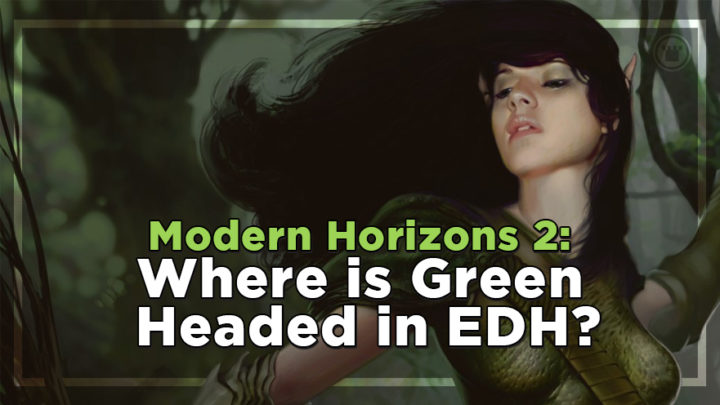Modern Horizons 2 preview season has been a blast, and we’ve seen many funky, fresh, and even irreverent designs. What’s got most people talking, though, is the fact that green seems overpowered. It’s an all-too-regular refrain if you follow releases, but what exactly is at the heart of this debate?
Green Gets Good Cards
Though the other colors have had their fair share of hits during preview season — from the likes of Persist and Ragavan, Nimble Pilferer to the landscape shifting Subtlety — it’s green that has once again been “trending.”
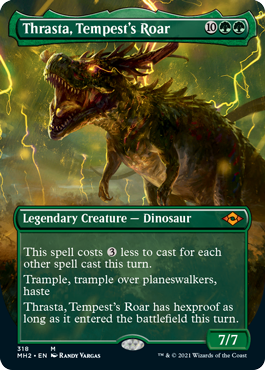
Early on in previews, we got Thrasta, Tempest’s Roar. Though the cost reduction condition might seem a little off the beaten path for green, there can be no doubt that this is a powerful card — if not for Modern, then certainly for Commander.
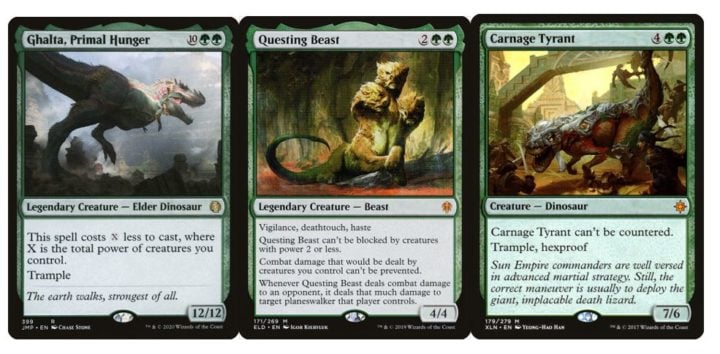
When you look at Thrasta, the card’s potential quickly becomes apparent. We can all remember Carnage Tyrant’s brief time commanding the tables during Ixalan Standard as a finisher in black-green decks, and to this day it’s a fun Cube option for green finishers. The cost reduction is reminiscent of Ghalta, Primal Hunger, and the ability to be on the beatdown while also dealing with planeswalkers is straight out of Questing Beast’s playbook.
The Anatomy of a Green Card
While green might have checks and balances in competitive formats, the same can’t always be said for Commander. If you ask an average Commander player what makes green so strong, they’re likely to come up with one of the following reasons:
- Green’s new design space covers weaknesses
- Green has access to some of the strongest effects in the game
- Green has redundancy
We see all these elements in Thrasta. It covers some of green’s weaknesses: it removes the choice of whether to deal with planeswalkers or try to kill a player, and it makes committing to a splashy creature less of an investment. We get to cast the splashy creature for close to free if we’ve cast a bunch of other spells that turn, and we get to mitigate risk with the conditional hexproof clause.
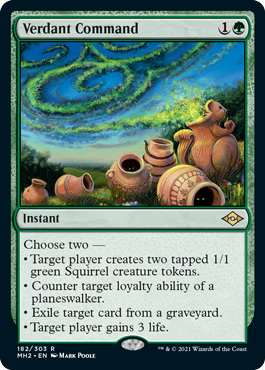
It’s pretty amusing, too, to see Verdant Command exploring similar design space. Meddling with loyalty abilities doesn’t feel like something green particularly needed, given it has efficient creatures to answer planeswalkers with already.
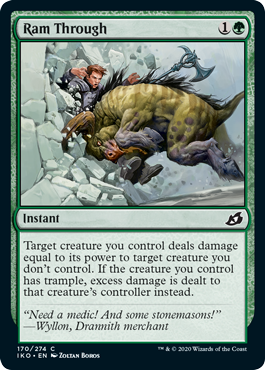
We’ve seen the impact of cards like Ram Through, too. It’s one of the best “burn spells” printed in recent years, and it isn’t even red. It’s a green spell, and one that even lets you avoid risking the creature you have in a fight. These days, green often gets to circumvent previous weaknesses, and it’s always going to provoke discussion.
Thrasta is also an example of some of the strongest effects in the game. Green is king when it comes to cost reduction and mana ramp, and one of the colors that gets combinations of trample, haste and hexproof most often. While Thrasta doesn’t draw cards, it’s still a very strong card which satisfies many of green’s conditions for drawing cards.
Finally — and most importantly to Commander players — green has redundancy. Thrasta is most definitely a redundant effect in EDH, and will fit into many brews centered around Dinosaurs, haste, and aggro.
There’s a reason why cards like Thrasta are quickly forgotten during preview season, and that’s because they’re often the third, fourth, or greater redundant effect for a color. Lightning Bolts, lifegain, hand disruption and counterspells aside, green is the color with the greatest redundancy in game effects that matter in Commander.
The Power of Redundancy
But what makes redundancy so strong in EDH? Well, at it’s basest level, it’s what allows you to experiment and run synergistic cards in diverse archetypes. One of the things holding white back is lack of redundancy; Sun Titan makes it into all number of white decks because there’s nothing quite like it.
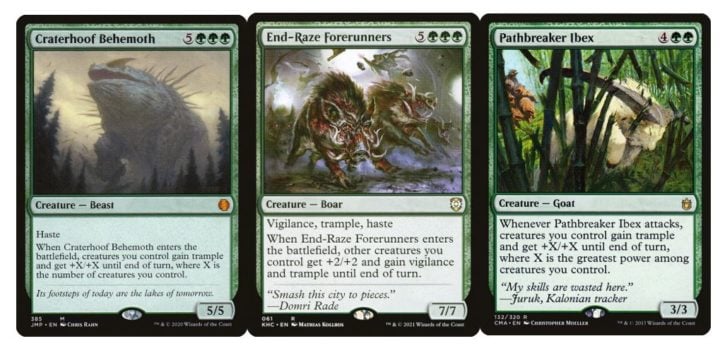
In green, if you can’t afford the Craterhoof, you can afford End-Raze Forerunners. If you’re in the right build, you might take Decimator of the Provinces for sacrifice value. If you’re playing a deck with access to haste, like Samut, Voice of Dissent? Pathbreaker Ibex is arguably the card of choice. I’ve named four of these finishers, but in truth, there are dozens more, from Siege Behemoth to Triumph of the Hordes. Some are functionally better than others, but all have a home.
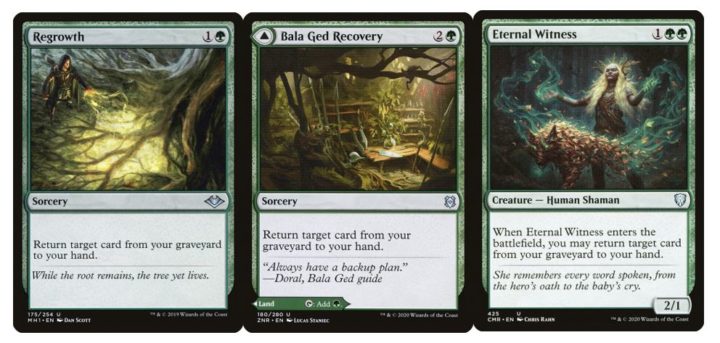
The same is true for one of green’s most powerful spells: Regrowth. Aside from the cards above, green also has multiple ways to gain access to this effect. Skullwinder is really sweet in decks that care about deathtouch or fight spells; Golgari Findbroker is excellent in a Golgari build; the list goes on. What makes green so great to brew with is the fact that you can access these powerful effects bundled with synergy, whether that’s tribal or mechanical. And what’s better than taking one? Taking multiple, of course. I’ve long said that Voltron decks want another Stoneforge Mystic, but we’ve yet to get one.
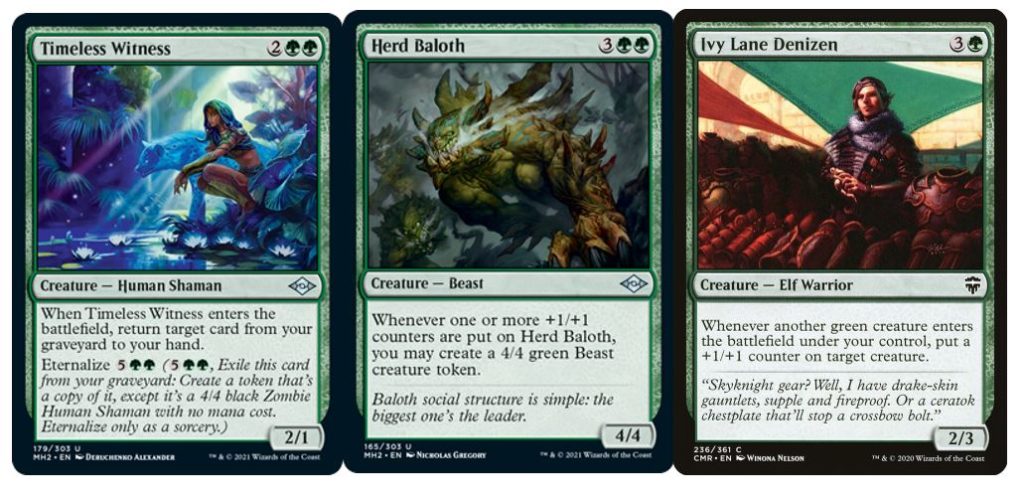
Green has a ton of redundancy in EDH, and it’s getting even more from Modern Horizons 2. Even though some excellent white cards were revealed on Thursday — like Esper Sentinel and Solitude — the conversation quickly turned to Timeless Witness and Herd Baloth. Green wasn’t lacking ways to make 4/4 tokens, or ways to combo with Ivy Lane Denizen, but sure — why not print another? And Timeless Witness? Sure, we’ll take another Eternal Witness.
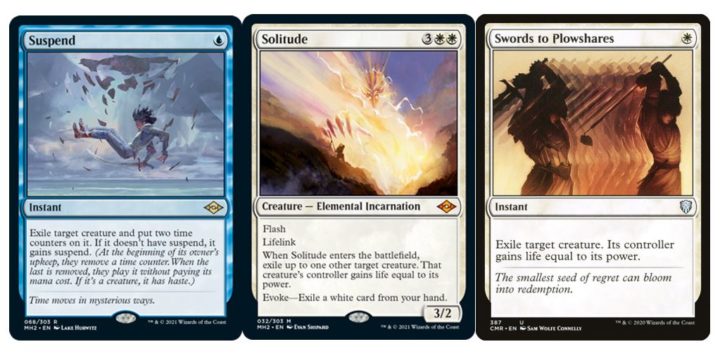
It’s all about the redundancy, which is also why Suspend (or Swords to Timeshares, as it has now affectionately been dubbed) ruffled feathers in the EDH community. White doesn’t have many redundant copies of instant-speed removal at one or two mana. Beyond Swords and Path to Exile, there’s only really the likes of Dispatch in an artifact deck that fit the bill. Everything else is a lot more conditional, relying on the creature being attacking, or giving a sizeable resource in the case of Angelic Ascension.
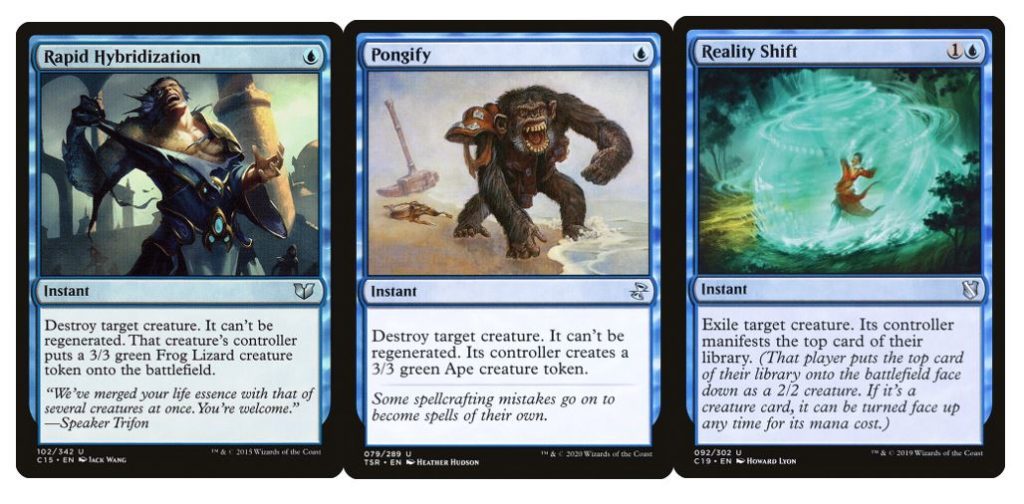
Contrast this with blue, which gets multiple cheap instant-speed answers, plus the likes of Resculpt, bringing artifact removal to blue with a worse token exchange than Angelic Ascension. And that’s not to mention the fact that blue can interact on the stack and counter those creatures before they even come into play, or bounce them back to hand when they threaten to attack or combo.
What makes Suspend so powerful in EDH is that often, games don’t go on long enough for the returning creature to make an impact. It’s one of the reasons Delay is so strong, being an easy-to-cast answer for any type of spell. Will the game be over before this spell goes back on the stack?
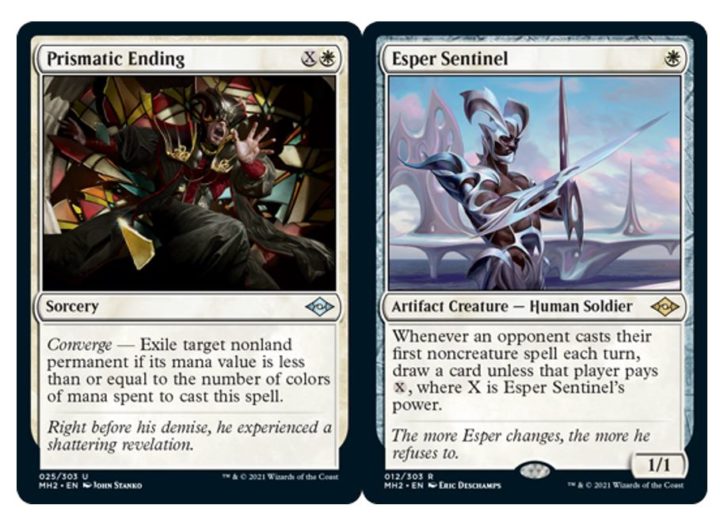
So, while Modern got some great picks, like the already underrated Prismatic Ending, Commander is still going to feel like a format where white is playing catch-up. While Solitude is awesome, and the same can be said for Esper Sentinel, players will always be left asking “thanks, what’s next?”
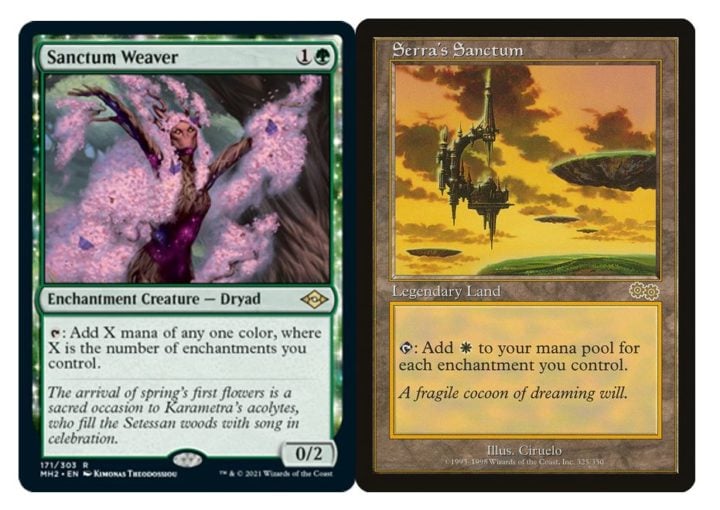
Until white gets redundant effects, people will still be left wanting, but furthermore, jealous when colors like green get to explore previous white space (Sanctum Weaver) or space green hasn’t yet (Yavimaya, Cradle of Growth).
You Can’t Have Your Cauliflower Pizza and Eat it
What many enjoyed as a meme — the idea that there was a hidden green cycle in MH2, made up from cards it was stealing from other colors — actually highlighted an important question. What’s actually the root issue here?
Well, the surface answer is obvious: green is getting to access previously unused or underused design space while other colors are still catching up. It’s not that people have an issue with green getting to do new things — it’s just that green is getting more tools than the other four colors.
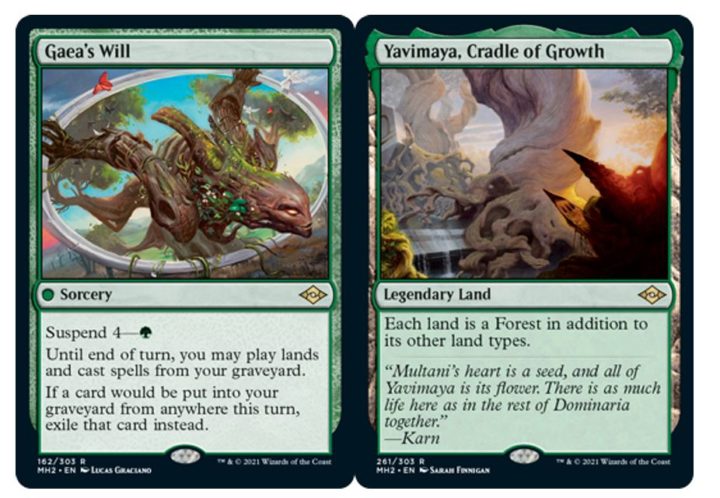
So when we see Gaea’s Will or Yavimaya in green, it’s less that the color can’t or shouldn’t do those things, but more that it isn’t justified in doing so, in a sense, while the pie is unbalanced — at least that’s the reasoning from disgruntled Magic players.
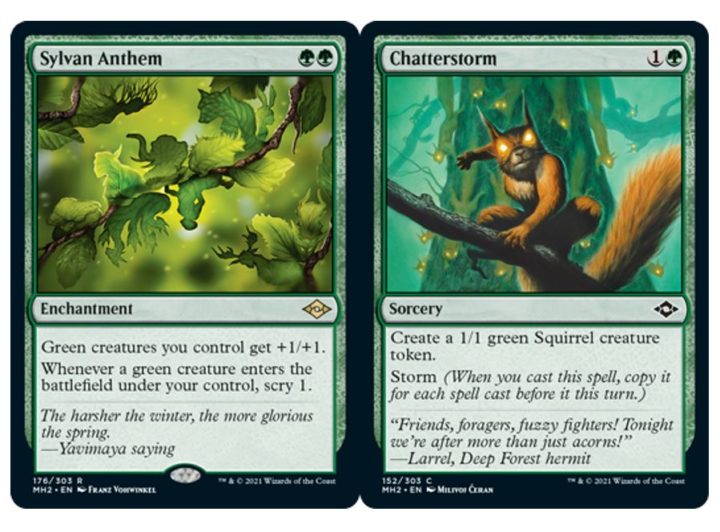
Why should green get access to a better version of Honor of the Pure? It’s a color that, Planar Chaos aside, has often cared very little about anthems. Chatterstorm, too, is a cheaper-to-cast Empty the Warrens that is functionally similar. Even if these effects are justifiable in other colors, it’s a complex question, and one I believe misses one of the biggest points: green is powerful because of redundancy.
I don’t envy those who have to design green cards at Wizards. It seems that they’re stuck between a rock and a hard place. Cards that are good for Standard and other competitive formats just end up adding to green’s redundancy in Commander.
The only way around that is to explore new design space — and, time and time again, we as Magic players lambast Wizards for that decision. It’s a tightrope walk for sure; trying to carve out new design space that doesn’t steal from other colors, or make the strongest color stronger, is a thankless task. I’m not entirely sure why the green Urborg, Tomb of Yawgmoth couldn’t have been Plains-centric, given white cares a lot about Plains, for example.
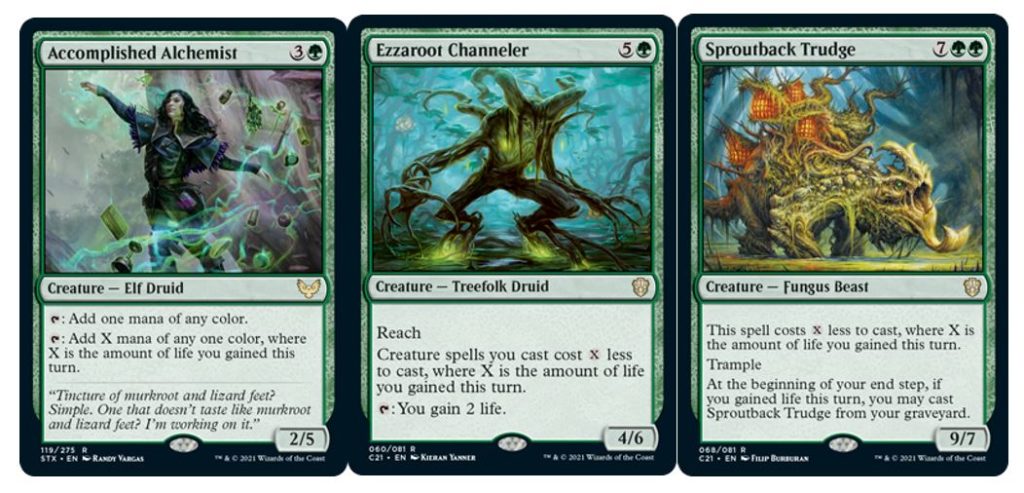
It’s also frustrating, I know, to see lifegain payoffs in Witherbloom in Strixhaven, especially given white lacks diversity in payoffs for the many ways it can gain life. It’s something that R&D have in the past said they’re working on, and it’s not the result we wanted. The compromise will never be perfect, and while we can hope that the issue is addressed without stealing too much from other colors, there’s a distinct feeling that we’re pretty far away from that ideal.
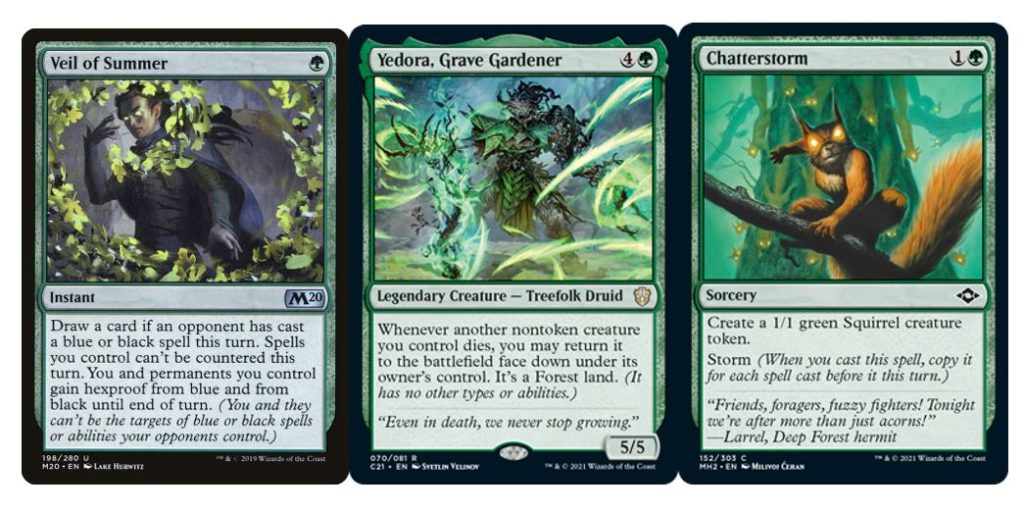
Either way, we need to realize that we can’t have it both ways. Green will keep getting redundant effects unless it explores new design space. Would you rather green get another Veil of Summer, or cards like Yedora or Chatterstorm?
In many ways, it’s a self-perpetuating cycle. Either green gets stronger through even more redundancy, or it explores new space — inevitably becoming stronger. Ultimately, we can’t have neither, so we’ll have to be comfortable with a healthy amount of both, and cultivate a healthier respect for the complexity of designing cards for an eternal format in which a color is seemingly ahead of the pack.

Kristen is Card Kingdom’s Head Writer and a member of the Commander Format Panel. Formerly a competitive Pokémon TCG grinder, she has been playing Magic since Shadows Over Innistrad, which in her opinion, was a great set to start with. When she’s not taking names with Equipment and Aggro strategies in Commander, she loves to play any form of Limited.

